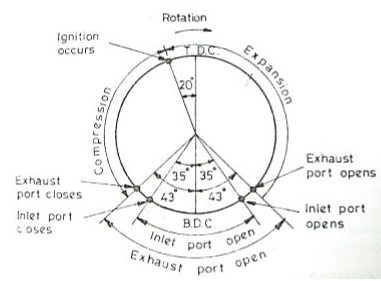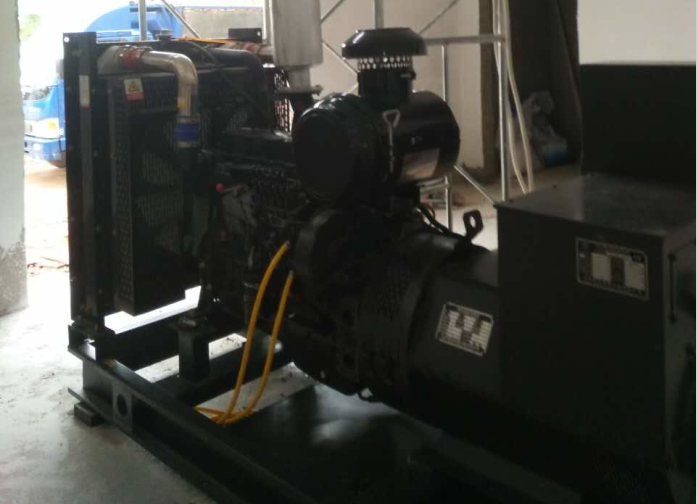Introduction of port timing and valve clearance of diesel generator sets
1. Port Timing
In principle, the intake, compression, work and exhaust processes of the genset diesel engine are started or completed when the piston reaches the top dead center and reaches the bottom dead center. However, in order to make the intake more fully, the exhaust is cleaner, and the intake and exhaust valves should be opened early and delayed. The timing at which the intake and exhaust of the diesel engine starts to open and close and the duration of the opening are usually expressed by the crank angle with respect to the upper and lower dead points, which is called the valve timing or the timing of the valve timing. A ring diagram showing the corresponding (timing) relationship between the intake and exhaust gas distribution of each cylinder, which is called the port timing companion (timing) diagram, as shown in Figure 1.

Near the top dead center, the angle at which the intake and exhaust valves are simultaneously opened is called the valve overlap angle. Since the fresh gas and the exhaust gas flow inertia are large, although the intake and exhaust valves are simultaneously opened, the air flows are not misaligned and mixed with each other.
The valve timing is determined according to the operating conditions of the diesel engine and the common speed. Different diesel engines have different gas distributions. The value of the valve phase is determined experimentally. In order to ensure the accuracy of the valve timing, special marks are usually provided between the crankshaft and the camshaft drive mechanism. During the assembly process, the marks must be aligned according to the requirements of the manual, and must not be arbitrarily changed.
2. Valve Clearance
When the diesel engine is working, the parts such as the valve, the push rod and the tappet are elongated due to the temperature rise. If it is assembled at room temperature, the valve and the transmission parts and the camshaft are in close contact. In the hot state, the valve will be closed tightly, causing the cylinder to leak. In order to ensure the sealing of the valve, a proper clearance must be left between the valve and the transmission member.
The valve train set must have a proper clearance when assembled at room temperature to compensate for the thermal expansion of the valve and each transmission component. This clearance is called the cold clearance of the valve. A certain valve clearance is also required during normal operation of the diesel engine (in the hot state) to ensure that the valve can be completely sealed when the cam does not act on the valve. The valve clearance of a diesel engine in a hot state is called the thermal clearance of the valve.
During the use of the diesel engine, due to the wear and deformation of the parts, the valve clearance will gradually increase, prompting the intake and exhaust valves to open late and close early, resulting in shorter intake and exhaust times, insufficient intake air, and exhaust gas. The power and economy of the diesel engine are degraded, and the impact and wear between the parts are intensified, and the noise is increased.
The valve clearance should be checked and adjusted regularly during use. The valve clearance of the diesel engine is generally given by the manufacturer. Each model has specific regulations. At normal temperature (cold clearance), the general intake valve clearance is between 0.20 and 0.35 mm, and the exhaust valve clearance is between 0.30 and 0.40 mm. between. It is best to adjust the valve clearance in the cold state and when the valve is completely closed. Because in the state of the heat engine, because the working time of the diesel engine is different, the machine temperature is not the same, and the size of the valve clearance is not easy to grasp. When adjusting, first rotate the crankshaft so that the piston of the cylinder to be adjusted is just at the top dead center of the compression stroke. At this time, the intake and exhaust valves are completely closed, and then the intake and exhaust valve clearance of the cylinder is adjusted by a screwdriver and a thickness gauge. After the adjustment is completed, adjust the other cylinders in the same way. To adjust the valve clearance, first loosen the lock nut of the adjusting screw, then rotate the adjusting screw, and insert the thickness gauge of the specified value into the valve stem and the rocker arm to measure, so that the valve clearance meets the requirements, and then adjust the lock. Tighten the nut tightly and review it until the valve clearance is within the specified range.
How to adjust the port timing of diesel generator sets
Inadequate gas distribution of diesel generator sets will result in insufficient intake air and unsmooth exhaust, resulting in incomplete combustion, affecting the power, economy and environmental protection of the unit. At this time, corresponding adjustment measures should be taken. It is recommended that you adjust the following methods.

1. Offset Camshaft Key Method
If most of the intake and exhaust valve timings are on one side and the phase difference values are close to each other, the offset key can be used to adjust. The offset camshaft key method is to adjust the cross-sectional shape of the connection key of the timing gear and the camshaft to adjust the phase of the valve. The change of the key shape causes the position of the timing gear and the camshaft to change by one. The corresponding angle is shifted, so that the phase of the valve is changed.
2. Camshaft Timing Gear Axial Movement Method
Since the timing gear of the lower camshaft is mostly helical gear, if the camshaft timing gear is axially displaced, the meshing position with the crankshaft timing gear can be changed, and the camshaft can be deflected by a certain angle to change the port timing. Position (camshaft axial clearance requirements remain the same). in actual repair, the timing gear is generally adjusted by changing the thickness of the thrust flange or the thickness of the timing gear hub.
The accuracy and reliability of the port timing have a great impact on the life of the diesel engine and the economics and dynamic performance of the diesel engine. Therefore, in the repair process of the diesel generator set, it is necessary to match the performance of the diesel engine and the working conditions. The bit is tested, verified, adjusted to get the correct or near-reasonable state.
Copyright © Guangxi Dingbo Generator Set Manufacturing Co., Ltd. All Rights Reserved | Sitemap
Update cookies preferences